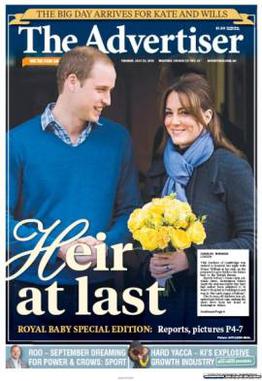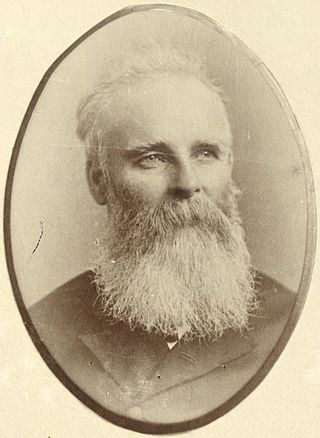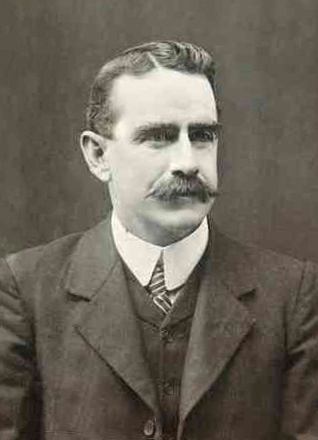Related Research Articles

The Advertiser is a daily tabloid format newspaper based in the city of Adelaide, South Australia. First published as a broadsheet named The South Australian Advertiser on 12 July 1858, it is currently a tabloid printed from Monday to Saturday. The Advertiser came under the ownership of Keith Murdoch in the 1950s, and the full ownership of Rupert Murdoch in 1987. It is a publication of Advertiser Newspapers Pty Ltd (ADV), a subsidiary of News Corp Australia, itself a subsidiary of News Corp. Through much of the 20th century, The Advertiser was Adelaide's morning broadsheet, The News the afternoon tabloid, with The Sunday Mail covering weekend sport, and Messenger Newspapers community news. The head office was relocated from a former premises in King William Street, to a new News Corp office complex, known as Keith Murdoch House at 31 Waymouth Street.

The Register, originally the South Australian Gazette and Colonial Register, and later South Australian Register, was South Australia's first newspaper. It was first published in London in June 1836, moved to Adelaide in 1837, and folded into The Advertiser almost a century later in February 1931.

George Edwin Yates, often referred to as Gunner Yates, was an Australian politician. He was an Australian Labor Party member of the Australian House of Representatives from 1914 to 1919 and from 1922 to 1931, representing the electorate of Adelaide.

Sampson Hosking was an Australian rules footballer who played for the Port Adelaide Football Club in the South Australian Football League (SAFL). He was twice a recipient of the Magarey Medal, an individual award given in recognition of being the best and fairest player in the SAFL. After his playing career Hosking was also an accomplished football coach successfully leading Port Adelaide and the West Torrens Football Club to a combined six premierships. In 1929 he was described in the Register as "one of the most prominent figures in the game during the past 20 years. Combining exceptional pace with a football brain of rare fertility".

Henry Kneebone was an Australian journalist, author, editor and politician.

Thomas Burgoyne was a builder and politician in the early days of the colony of South Australia.

The Bunyip is a weekly newspaper, first printed on 5 September 1863, and originally published and printed in Gawler, South Australia. Its distribution area includes the Gawler, Barossa, Light, Playford, and Adelaide Plains areas. Along with The Murray Pioneer, The River News, and The Loxton News,The Bunyip was now owned by the Taylor Group of Newspapers and printed in Renmark.
This is a list of captains and boat owners and others important in the history of the Murray-Darling steamer trade, predominantly between 1850 and 1950.

The Southern Cross is the official publication of the Catholic Archdiocese of Adelaide. About 5000 copies are printed monthly and distributed to parishes, schools and agencies, besides an online version. It began in July 1889 as a weekly magazine published in Adelaide, South Australia, for the Catholic Archdiocese of Adelaide, and remained a weekly for most of its history. Its banner was subtitled A weekly record of Catholic, Irish and General Intelligence, and later Organ of the Catholic Church in South Australia. The current, non-print website version of the magazine also bears the name Southern Cross.
Quiz was a weekly newspaper published in Adelaide, South Australia from 1889 to 1910. Between 1890 and 1900 it was known as Quiz and The Lantern.

William Joseph Denny was an Australian journalist, lawyer, politician and decorated soldier who held the South Australian House of Assembly seats of West Adelaide from 1900 to 1902 and then Adelaide from 1902 to 1905 and again from 1906 to 1933. After an unsuccessful candidacy as a United Labor Party (ULP) member in 1899, he was elected as an "independent liberal" in a by-election in 1900. He was re-elected in 1902, but defeated in 1905. The following year, he was elected as a ULP candidate, and retained his seat for that party until 1931. Along with the rest of the cabinet, he was ejected from the Australian Labor Party in 1931, and was a member of the Parliamentary Labor Party until his electoral defeat at the hands of a Lang Labor Party candidate in 1933.

Elizabeth Rose Hanretty (1881–1967) was an Australian political activist. She was a prominent woman in the labour movement, and served as the Australian Labor Party's South Australian assistant state secretary for forty years.
This is a list of candidates of the 1924 South Australian state election.
Truth was the name of various weekly newspapers published in Adelaide, South Australia, at times between 1890 and 1964.
The Port Adelaide News was a newspaper published in Port Adelaide, South Australia between 1876 and 1933 with various sub-titles, several breaks in publication and periods of bi-weekly publication.
The Kapunda Herald was a newspaper published in Kapunda, South Australia from 29 October 1864 to 25 January 1951. From 1864 to 1878 the masthead was subtitled "and Northern Intelligencer". It was published weekly, except for the period February 1872 to September 1894 when it appeared bi-weekly. When closed, the newspaper was merged with the Barossa News to become the Barossa and Light Herald.
The Australische Zeitung was a weekly German-language newspaper published in Tanunda, South Australia from 1860 until it ceased publication during World War I in 1916 due to anti-German sentiment. The newspaper also existed in a variety of earlier names or merged publications, reflecting the fluid nature of the newspaper industry in Victorian gold rush era colonial South Australia. The long history of German language Australian newspapers reflects the considerable German-speaking population which settled in South Australia in the nineteenth century.
Peter Bond Burgoyne was an English wine merchant, founder and head of P. B. Burgoyne and Co., Ltd., and Australian Wine Importers, Ltd. He has been called "the father of the Australian wine industry in Great Britain".
Wondergraph, Wondergraph Theatre and variations were names given first to a technology, and then to picture theatres run first by the Continental Wondergraph Company ; and then, in Adelaide, South Australia, by the Wondergraph Company (1910–1911), and then the Greater Wondergraph Company, established around 1911 and in existence until 1939.
References
- ↑ Jim Moss, Sound of Trumpets Wakefield Press, Adelaide 1985 p.163 ISBN 0 949268 05 4
- 1 2 3 "Growth of the Paper". Daily Herald. Vol. 2, no. 317. South Australia. 11 March 1911. p. 14. Retrieved 15 June 2016– via National Library of Australia.
- ↑ "A New Weekly Democratic Paper". South Australian Register . Vol. LIX, no. 14, 927. 15 September 1894. p. 6. Retrieved 15 June 2016– via National Library of Australia. Ten shillings, which converted to $1 in 1966, would equate to around $50 in today's values.
- ↑ "Labor's New Editor". The Mail . Adelaide. 25 April 1914. p. 13. Retrieved 22 July 2013– via National Library of Australia.
- ↑ "Yachting Yabber". Quiz and The Lantern . Vol. VI, no. 293. South Australia. 11 April 1895. p. 5. Retrieved 1 September 2020– via National Library of Australia.
- ↑ "Who's Who in the Sporting World". Saturday Journal . Vol. XL, no. 16275. South Australia. 14 March 1925. p. 14. Retrieved 1 September 2020– via National Library of Australia.
- ↑ "The 'Herald'". Daily Herald. Adelaide. 26 March 1918. p. 4. Retrieved 21 July 2013– via National Library of Australia.
- ↑ "The Daily 'Herald'". The Herald. Adelaide. 12 February 1910. p. 8. Retrieved 22 September 2014– via National Library of Australia.
- ↑ "What Our Readers Think". The News (Home ed.). Adelaide. 9 January 1925. p. 6. Retrieved 22 September 2014– via National Library of Australia.
- ↑ "Obituary". The Chronicle . Adelaide. 18 February 1922. p. 14. Retrieved 22 September 2014– via National Library of Australia.
- ↑ "Journalist Leaves Perth". The News (Home ed.). Adelaide. 4 March 1924. p. 10. Retrieved 22 September 2014– via National Library of Australia.
- ↑ "Alleged Libel". The Register . Adelaide. 20 June 1923. p. 9. Retrieved 22 July 2013– via National Library of Australia.
- ↑ "Death of Mr. W. R. Pratt". The Sydney Morning Herald . 8 October 1927. p. 22. Retrieved 22 September 2014– via National Library of Australia.
- ↑ "On The Set With Cinesound". The Singleton Argus . NSW. 20 December 1935. p. 2. Retrieved 22 September 2014– via National Library of Australia.
- ↑ "Personal". The Port Macquarie News and Hastings River Advocate . NSW. 28 August 1943. p. 5. Retrieved 22 September 2014– via National Library of Australia.
- ↑ "Town Tattle". Bunyip . Gawler, SA. 8 May 1914. p. 2. Retrieved 22 July 2013– via National Library of Australia.
- ↑ "Personal". Daily Standard (Brisbane) . No. 33. Queensland, Australia. 17 January 1913. p. 4. Retrieved 5 September 2020– via National Library of Australia.
- ↑ "Exit the Daily Herald". The Register . Adelaide. 24 June 1924. p. 8. Retrieved 22 July 2013– via National Library of Australia.
- ↑ "The Turf World". The Daily Herald (Adelaide) . Vol. 9, no. 2791. South Australia. 1 March 1919. p. 7. Retrieved 28 July 2017– via National Library of Australia.
- ↑ "Journalist's Successful Claim". The Journal . Vol. LIV, no. 14882. Adelaide. 27 March 1919. p. 1. Retrieved 6 August 2017– via National Library of Australia.
- ↑ "The Daily Herald Sued". Daily Herald. Vol. X, no. 2803. South Australia. 15 March 1919. p. 7. Retrieved 6 August 2017– via National Library of Australia.
- ↑ "A Printing Company in Court". South Australian Register . Vol. LXI, no. 15, 350. 24 January 1896. p. 5. Retrieved 14 June 2016– via National Library of Australia.
- ↑ "The Daily Herald Plant". Daily Herald (Adelaide). Vol. 1, no. 1. South Australia. 7 March 1910. p. 3. Retrieved 12 June 2016– via National Library of Australia.
- ↑ "General News". The Southern Cross . Vol. XXV, no. 1265. South Australia. 28 November 1913. p. 11. Retrieved 15 June 2016– via National Library of Australia.